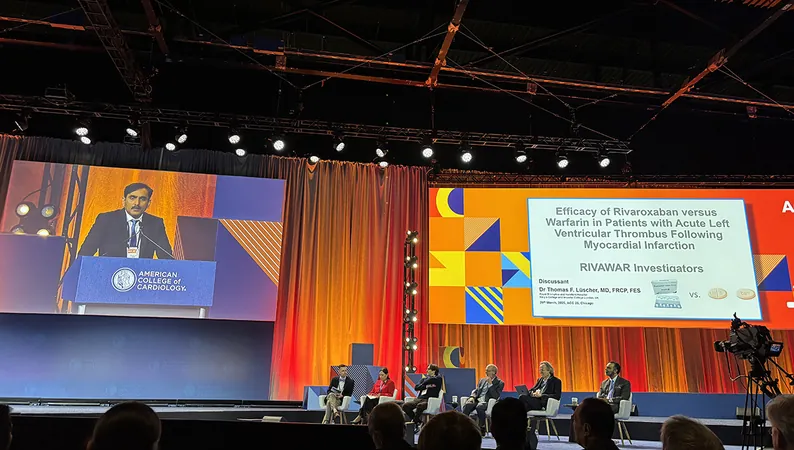
RIVAWAR Study Reveals Rivaroxaban as Effective as Warfarin for LV Thrombus Post-Heart Attack
2025-04-02
Author: Siti
Chicago, IL —
A groundbreaking study, known as RIVAWAR, has found that patients who develop a thrombus in the left ventricle following a myocardial infarction (MI) can be treated just as effectively with rivaroxaban (marketed as Xarelto by Bayer/Janssen) as they are with the traditional anticoagulant warfarin. Results presented at the prestigious American College of Cardiology 2025 Scientific Session indicate that both treatments lead to significant clot resolution within three months.
What makes rivaroxaban particularly appealing is its simplified dosing regimen. Unlike warfarin, which requires frequent blood monitoring and comes with a myriad of food-drug interactions, rivaroxaban offers a more straightforward approach, presenting itself as a "viable alternative" for these patients according to lead researcher Dr. Jehangir Ali Shah from the National Institute of Cardiovascular Diseases in Karachi, Pakistan.
Dr. Shah emphasized the user-friendliness of rivaroxaban, stating, “You don’t need to monitor blood samples. You don’t need to monitor other drugs or food.” This ease of use could turn it into a preferred treatment, especially for patients battling the aftermath of a severe heart attack.
Despite advancements in primary Percutaneous Coronary Intervention (PCI) and adjunctive antithrombotic therapies reducing the occurrence of left ventricular thrombus formation, experts like Dr. Thomas Lüscher from Royal Brompton and Harefield Hospitals highlighted that the complication still presents a vital clinical concern. Patients suffering from thrombus formation could experience a stroke following a severe myocardial infarction, with incidence rates estimated at around 9% for those with anterior STEMI (ST-Elevation Myocardial Infarction).
A Game-Changer in Cardiac Care
The RIVAWAR study randomized 261 patients, predominantly male with an average age of 54.5 years, diagnosed with left ventricular thrombus within a week of experiencing STEMI or non-STEMI (NSTEMI). Patients were assigned to either rivaroxaban or warfarin for a 12-week duration, with echocardiographic assessments occurring at the 4 and 12-week marks. Notably, over 90% of the patients presented with STEMI, and 85% underwent PCI.
The findings revealed that thrombus resolution at four weeks was observed in 20.1% of rivaroxaban patients compared to just 8.3% in the warfarin group. By the 12-week follow-up, the rates of thrombus resolution were nearly equal, standing at 95.8% for rivaroxaban and 96.6% for warfarin, demonstrating that rivaroxaban meets noninferiority standards.
As Dr. Shah remarked, these results are potentially transformative for the treatment of patients post-MI, suggesting that rivaroxaban could become the new standard of care. Dr. Anna Bortnick from Albert Einstein College of Medicine echoed these sentiments, describing rivaroxaban as a “pop-and-go” strategy that simplifies patient management compared to the complexities associated with warfarin.
With such promising results from the RIVAWAR study, healthcare practitioners may soon have a powerful new tool in their arsenal to improve outcomes for patients recovering from myocardial infarctions. The cardiac community watches closely as further research and clinical practices might very well pivot towards this innovative anticoagulant.


 Brasil (PT)
Brasil (PT)
 Canada (EN)
Canada (EN)
 Chile (ES)
Chile (ES)
 Česko (CS)
Česko (CS)
 대한민국 (KO)
대한민국 (KO)
 España (ES)
España (ES)
 France (FR)
France (FR)
 Hong Kong (EN)
Hong Kong (EN)
 Italia (IT)
Italia (IT)
 日本 (JA)
日本 (JA)
 Magyarország (HU)
Magyarország (HU)
 Norge (NO)
Norge (NO)
 Polska (PL)
Polska (PL)
 Schweiz (DE)
Schweiz (DE)
 Singapore (EN)
Singapore (EN)
 Sverige (SV)
Sverige (SV)
 Suomi (FI)
Suomi (FI)
 Türkiye (TR)
Türkiye (TR)
 الإمارات العربية المتحدة (AR)
الإمارات العربية المتحدة (AR)